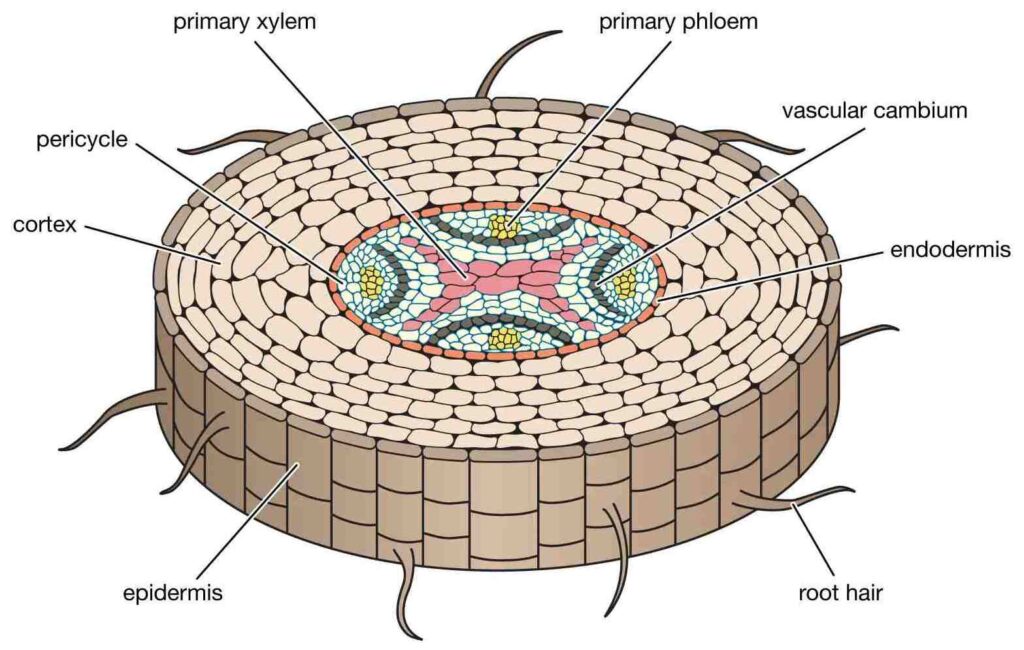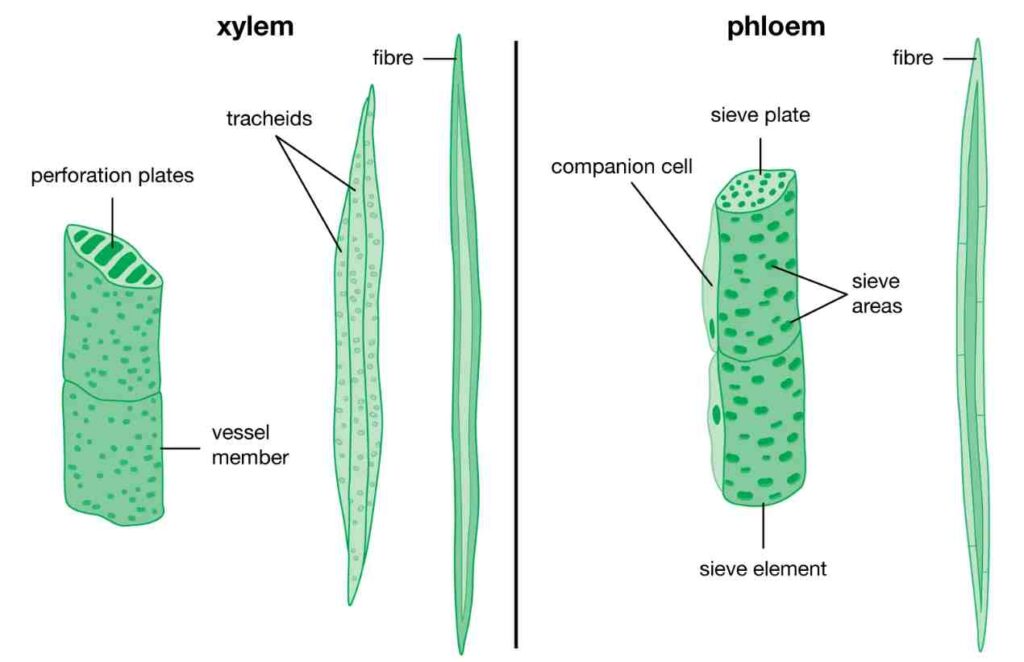Dicot root

Dicot roots extend deeply into the soil as a single, thick root with lateral branches. This type of root structure is known as a taproot. The major vascular structures of dicot roots are surrounded by the ground tissue, which is mainly made up of parenchyma cells.
Beneath the soil, hidden from the prying eyes of the sun, lies a complex network of roots that anchors plants, absorbs vital nutrients, and transports them throughout the organism. Among these root systems, dicot roots stand out for their distinct structural organization, a testament to the intricate and efficient design of nature.
This exploration delves into the captivating world within a dicot root, unraveling its internal structure layer by layer, from the outermost protective layer to the innermost core. This intricate architecture, a symphony of cells and tissues working in perfect harmony, forms the foundation of a plant’s success and survival.
Table of Contents
Stepping into the Root: From the Outside In
As we embark on our journey, we first encounter the epidermis, the outermost protective shield of the root. This single layer of tightly packed cells forms a barrier against the harsh environment of the soil, safeguarding the delicate tissues within. The epidermis also harbors specialized cells called root hairs, which greatly increase the surface area of the root, facilitating efficient water and nutrient absorption.
Beneath the epidermis lies the cortex, a broad expanse of parenchyma cells. These cells are loosely packed, creating interconnected air spaces that allow for gas exchange and provide structural support. The cortex also plays a crucial role in storing food reserves, contributing to the plant’s ability to endure periods of stress and scarcity.
The Vascular Cylinder: A Central Hub of Activity
At the heart of the dicot root lies the vascular cylinder, a central core responsible for the efficient transport of water, nutrients, and sugars throughout the plant. This intricate structure is composed of two distinct tissues: the xylem and the phloem.
Xylem

This specialized tissue acts as a network of pipes that conduct water and dissolved minerals from the roots to the rest of the plant. Xylem cells are dead at maturity, leaving behind empty, interconnected tubes that efficiently transport fluids throughout the plant.
Phloem

In contrast to the xylem, the phloem consists of living cells that transport sugars produced by photosynthesis from the leaves to other parts of the plant. Phloem cells are connected by sieve plates, specialized openings that allow for the flow of nutrients.
The Endodermis: A Gateway to the Vascular Cylinder
Enclosing the vascular cylinder is the endodermis, a single layer of cells that acts as a selective barrier, regulating the flow of substances into the vascular tissues. The endodermis is characterized by the presence of Casparian strips, bands of waterproof material that prevent water and dissolved minerals from entering the vascular cylinder through the cell walls, forcing them to pass through the plasma membrane of the endodermal cells. This selective control ensures that only essential nutrients reach the vascular tissues, while potentially harmful substances are excluded.
The Pericycle: A Multifaceted Layer
Just inside the endodermis lies the pericycle, a layer of meristematic cells capable of undergoing cell division. This vital tissue contributes to the lateral growth of the root, enabling the formation of lateral roots, which extend from the main root and increase its absorption surface area. The pericycle also plays a role in the development of the vascular cambium, a lateral meristem that produces secondary xylem and phloem, contributing to the growth of the root in diameter.
A Tale of Two Tissues: Primary and Secondary Growth
The internal structure of a dicot root reflects its dynamic growth process, which can be categorized into primary and secondary growth.
Primary Growth
This initial phase of growth, driven by apical meristems located at the root tip, is responsible for the elongation of the root. The primary tissues, including the epidermis, cortex, endodermis, and vascular cylinder, are all established during this stage.
Secondary Growth
Once the primary growth is complete, secondary growth begins, driven by the vascular cambium and cork cambium. This process results in an increase in the diameter of the root, enabling it to support the increasing size and complexity of the plant. Secondary xylem, also known as wood, forms a solid core, providing structural support and water transport. Secondary phloem contributes to the transport of sugars throughout the plant.
A Symphony of Specialization: Tissues Working in Harmony
The intricate internal structure of a dicot root is a testament to the remarkable efficiency of plant design. Each tissue, with its unique composition and function, contributes to the overall success of the plant, allowing it to thrive in a diverse range of environments.
The epidermis acts as a protective shield, the cortex serves as a storage and support system, the vascular cylinder ensures efficient transport, the endodermis regulates nutrient flow, the pericycle facilitates lateral growth, and the cambium drives secondary growth. This orchestrated symphony of specialization allows the dicot root to perform its vital functions with remarkable precision and efficiency.
A Glimpse into the Root’s Role in Plant Life
The internal structure of a dicot root is not merely a fascinating study in botanical anatomy; it is a testament to the vital role roots play in the lives of plants. From anchoring them securely in the soil to absorbing life-giving water and nutrients, roots are the unsung heroes of the plant kingdom. They are the hidden foundation upon which the entire plant rests, ensuring its growth, survival, and ultimately, its ability to contribute to the delicate balance of ecosystems.
By understanding the internal structure of a dicot root, we gain a deeper appreciation for the intricacies of plant life and the remarkable adaptations that allow them to flourish in a constantly changing world. This journey into the heart of the root reveals not only the beauty of its design but also the profound significance of its function in the world of plants and ecosystems alike.
Frequently Asked Questions(FAQ)
What do you mean by Endodermis?
The vascular tissue (xylem and phloem) in the roots and stems of vascular plants is surrounded by a single layer of cells called the endodermis. It is essential for controlling how nutrients and water are moved throughout the plant.
What do you mean by Tissues?
Tissue is just a collection of cells that share a common structure and function; these cells are called tissues. They constitute an intermediary cellular organizational level situated between the organ system and the cells. Tissue functional groups are then combined to form organs.
Related Articles

